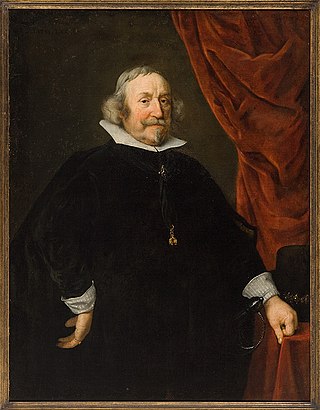
Johann Wilhelm II, Elector Palatine of the Wittelsbach dynasty was Elector Palatine (1690–1716), Duke of Neuburg (1690–1716), Duke of Jülich and Berg (1679–1716), and Duke of Upper Palatinate and Cham (1707–1714). From 1697 onwards Johann Wilhelm was also Count of Megen.

The Alte Pinakothek is an art museum located in the Kunstareal area in Munich, Germany. It is one of the oldest galleries in the world and houses a significant collection of Old Master paintings. The name Alte (Old) Pinakothek refers to the time period covered by the collection—from the fourteenth to the eighteenth century. The Neue Pinakothek, re-built in 1981, covers nineteenth-century art, and Pinakothek der Moderne, opened in 2002, exhibits modern art. All three galleries are part of the Bavarian State Painting Collections, an organization of the Free state of Bavaria.

Neuburg an der Donau is a town which is the capital of the Neuburg-Schrobenhausen district in the state of Bavaria in Germany.
The Kunstareal is a museum quarter in the city centre of Munich, Germany.

William IV was Duke of Bavaria from 1508 to 1550, until 1545 together with his younger brother Louis X, Duke of Bavaria. He was born in Munich to Albert IV and Kunigunde of Austria, a daughter of Emperor Frederick III.

Palatinate-Neuburg was a territory of the Holy Roman Empire, founded in 1505 by a branch of the House of Wittelsbach. Its capital was Neuburg an der Donau. Its area was about 2,750 km², with a population of some 100,000.

The Massacre of the Innocents is the subject of two paintings by Peter Paul Rubens depicting the episode of the biblical Massacre of the Innocents of Bethlehem, as related in the Gospel of Matthew (2:13–18). The first, measuring 142 x 182 cm, was painted after his return to his native Antwerp in 1608, following eight years spent in Italy.

The Picture Gallery in the Sanssouci Park of Potsdam was built in 1755–64 during the reign of Frederick II of Prussia under the supervision of Johann Gottfried Büring. The Picture Gallery is situated east of the palace and is the oldest extant museum built for a ruler in Germany.

Magdalene of Bavaria was a German princess of the House of Wittelsbach who became Countess Palatine of Neuburg and Duchess of Jülich-Berg by marriage.

Freising Cathedral, also called Saint Mary and Corbinian Cathedral, is a romanesque basilica in Freising, Bavaria. It is the co-cathedral of the Catholic Archdiocese of Munich and Freising. Freising Cathedral is also known for being the place where Pope Benedict XVI was ordained a priest.

Adriaen van der Werff was a Dutch painter of portraits and erotic, devotional and mythological scenes. He painted several works for the Medicis. His brother, Pieter van der Werff (1661–1722), was his principal pupil and assistant.

The Honeysuckle Bower is a self-portrait of the Flemish Baroque painter Peter Paul Rubens and his first wife Isabella Brant, executed c. 1609.The couple is seated in fine clothes within a garden composition and a vine of honeysuckle is placed overhead. The symbolism of the double-portrait alludes to meanings of love and marriage, such as the holding of right hands, and the concept of the garden of love. The pose of the two figures and their fine clothing signify self-fashioning by Rubens. They wed in 1609, the same year that work was created; it was ultimately given to Isabella’s father Jan Brant and would later end up in the collection of Johann Wilhem II of Düsseldorf. The couple would be married for seventeen years, and have three children before Isabella died in 1625. Her death would have a profound impact on Rubens and through his loss he created an posthumous portrait.

Wolfgang Wilhelm von Pfalz-Neuburg was a German Prince. He was Count Palatine of Neuburg and Duke of Jülich and Berg.

The Bavarian State Painting Collections, based in Munich, Germany, oversees artwork held by the Free State of Bavaria. It was established in 1799 as Centralgemäldegaleriedirektion. Artwork includes paintings, sculptures, photographs, video art and installation art. Pieces are on display in numerous galleries and museums throughout Bavaria.

Anna of Cleves was a daughter of Duke William V of Jülich-Berg and his wife, Maria of Austria.

The Neuburg Castle is a palace in Neuburg an der Donau, Upper Bavaria.

Wolfgang George Frederick Franz von Pfalz-Neuburg was an Auxiliary Bishop in the Diocese of Köln and elected Prince-Bishop of Breslau (Wrocław) shortly before his death.

The Rape of the Daughters of Leucippus is a 1618 painting by Peter Paul Rubens and Jan Wildens. It is displayed at the Alte Pinakothek in Munich.

The Reconciliation of Esau and Jacob is a 1624 painting by Peter Paul Rubens. Originally in the Spanish royal collection, it was sent to Germany by Maria Anna of Neuburg to her brother Johann Wilhelm. It is now in the Staatsgalerie Schleissheim near Munich.

















